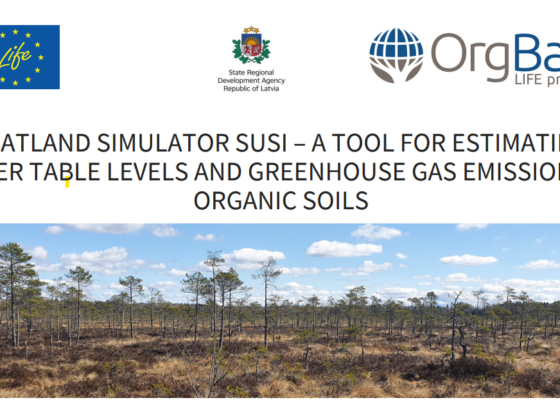LIFE OrgBalt has published article about Peatland simulator SUSI – a tool for estimating water table levels and greenhouse gas emissions in organic soils. Full article available HERE.
LIFE OrgBalt contributes to improving the national greenhouse gas (GHG) inventories in the project regions by both establishing demonstration sites where GHG emissions are measured and using tools for estimating GHG emissions where actual measurements are not available. The Peatland simulator SUSI created by the Natural Resource Institute Finland (Luke) uses a hydrological model which requires inputs of weather and stand data to estimate water table levels and create projections of GHG emission levels in organic soils. In this technical article, the key principles of the simulator are explained.
Peatland soils and drainage
The peatland simulator SUSI is a software package for modelling the forested peatland ecosystem hydrology, stand growth and nutrient availability under different management, site types and weather conditions. Given input weather and stand data, SUSI calculates various quantities of interest for making projections and comparing management options. The core of SUSI is a strip hydrology model, which simulates the water table level on a linear strip perpendicular to two bordering ditches. Hydrology, along with other components of the software, are in turn used to estimate, for example, greenhouse gas emissions, nutrient flows, and stand growth.
Most importantly, projections of greenhouse gas emissions can be made based on knowledge of the water table and other quantities in the model. The value of the model is in producing these estimates for sites for which actual greenhouse gas measurements are not available. Modelling only requires weather and stand data, which are readily available.
Description of the Model
The SUSI model was recently published in Forests (doi: 10.3390/f12030293). The publication describes the structure and equations of the model, as well as validates the model against a wide variety of data from Finland.
A Python implementation of the model is publicly available at https://github.com/annamarilauren/susi, making the simulator accessible by anyone. The required inputs to the model are a few site-specific parameters, daily weather data, and stand growth curves with biomass partitioning.
The key component of the model is soil hydrology simulation on a strip reaching from one ditch to another. Effective water inputs to the soil profile are calculated from the input rainfall values, interception by the tree stand and ground vegetation, and surface runoff and evapotranspiration. The soil water profile then approaches an equilibrium with the bordering outputs, which are the ditches on both sides of the strip.
Utilisation in the LIFE OrgBalt project
Within the LIFE OrgBalt project, the published model has been expanded to estimate methane and dinitrogen oxide emissions, in addition to the carbon dioxide releases in the original description. Additionally, improvements have been made to the simulator interface, making it more accessible to the research community. It is planned that the model will be utilised to produce large scale emission projections from organic soils for the involved countries to improve the greenhouse gas inventory in each country.


